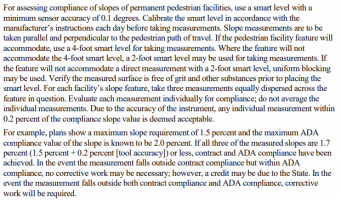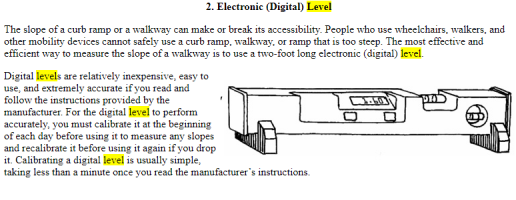When measuring surfaces for cross slope and running slopes is there any requirement to use a specific length level? I get reports from people using 2' levels and the slope issues are everywhere. people using 4' levels and the slope problems are reduced considerably. Using a 8' level and the slope issues are again reduced. I typically use a 4' smart level. When I use the 2' level I can pretty much get it to read what I want with small relocations of the level. Seems like a specific length level should be required.
Is there any standard for this?
Now how about measuring the door operating pressures. exterior swing door in CA requires a 5# max operating pressure. The force needed to unlatch and get the door moving can be higher (how high) I thought I read somewhere 25# but cannot pinpoint. Is there a standard for how is this measured? I usually get the door moving with my foot then apply pressure gauge to see if I can keep it moving at 5#. Once again any referenced standard for this measurement would be appreciated.
Is there any standard for this?
Now how about measuring the door operating pressures. exterior swing door in CA requires a 5# max operating pressure. The force needed to unlatch and get the door moving can be higher (how high) I thought I read somewhere 25# but cannot pinpoint. Is there a standard for how is this measured? I usually get the door moving with my foot then apply pressure gauge to see if I can keep it moving at 5#. Once again any referenced standard for this measurement would be appreciated.



